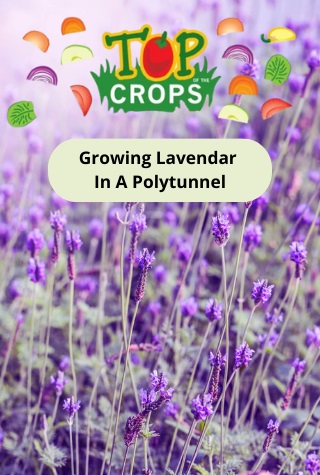Lavender is not only a delight to gardeners. it is wonderful for wildlife too. Beloved by bees and other pollinators, it is just as useful in your garden as it can be inside your home. This can be a great choice for a domestic or commercial polytunnel .
| Jan | Feb | Mar | Apr | May | Jun | Jul | Aug | Sep | Oct | Nov | Dec | |
| Plant |  |
 |
||||||||||
| Harvest |  |
 |
 |
Lavenders, in the Lavandula genus, are flowering shrubs or sub-shrubs native to the Mediterranean region. They have attractive grey-green to mid green leaves and delightfully fragranced, bee-friendly flowers.
While so-called 'English lavender' is typically the best choice for UK gardens, there are also a range of other interesting lavender varieties to consider growing either in a polytunnel or elsewhere in your garden.
If you would like to grow lavender, then it is important to understand that there are different varieties, some fully hardy, some half-hardy and some tender, and these have somewhat different needs. However, all lavenders need:
A site in full sun.
Poor and dry or moderately fertile soil that is free-draining.
Lavenders generally cannot thrive in a shady, extremely cold or waterlogged location. However, they are tolerant of a range of soil conditions as long as the soil is not too wet or heavy, and can tolerate drought.
This is a shrub that, as long as you choose the right growing location, is remarkably easy to grow. Wherever you choose to plant it, it is a simple and straightforward process.
Lavender is usually best planted out in the spring, as the soil begins to warm and spring comes into full life. Between April and early June. A number of different lavender plants in pots are available in garden centres and plant nurseries at this time of the year.
You can grow lavender outdoors or in a polytunnel garden. This is a plant that can be useful, structurally and functionally, and look wonderful, in a range of settings.
Lavender can be used:
As a beneficial companion plant for a range of other edible and useful plants.
As path or bed edging, or low boundary hedges.
In mixed beds or borders, alongside other Mediterranean herbs and/or flowers.
In a container garden. (Especially more tender types that benefit from being moved indoors or undercover in winter.)
Remember however that all lavenders do need a sunny and free-draining spot.
Lavender is ideally placed into light and friable soil or a similar growing medium in containers. If the soil is on the heavier side then it is a good idea to plant lavender on mounds or ridges around 20-30cm high so that it is easier for excess water to drain away.
You should plant out lavender into its final growing position as soon as possible after purchase. Spacing will vary depending on the variety you have chosen and how large it will grow, as well as on the specific planting location and positioning of the lavender within your garden plans.
Lavender growing in groups are typically spaced widely, around 70-90cm apart.
For hedges, lavenders are generally placed more closely, between 30 and 45cm apart.
Lavender can also be planted into containers that are around 30-40cm across, filled with a multipurpose, or loam-based, peat free potting mix with around 25% grit by volume to improve drainage.
When planting, make sure the lavender sits at the same level in the soil or growing medium that it did in its previous container.
Lavender is relatively drought tolerant once established. But it should be well watered during dry spells for its first summer. Container grown plants will continue to need watering through the summer as they will dry out more quickly than those in the ground.
Of course, you will also need to water if your lavender is grown in a location such as a polytunnel where natural rainfall is not available. For plants grown outside in the ground, natural rainfall is usually sufficient.
In winter, excess rain can often be more of a problem than winter cold. So plants may need to be brought undercover for this part of the year to reduce water access, depending on which type of lavender you have chosen to grow.
Lavender does not need feeding. In fact, this is a plant that thrives in relatively low-nutrient conditions.
Cutting off the blooms once they are spent earlier in the season can encourage more to form. However, you may already have chosen to harvest the flowers while they were in bloom for use within your home.
Towards the end of the season, don't deadhead too zealously. It is a good idea to leave the flowers to set seed, as they provide food for wildlife, including seed-eating bird species like goldfinches.
It is important to understand that some lavenders are much hardier than others. It is important to know how hardy the variety is that you have chosen to grow.
English lavender and its hybrids are the hardiest lavender varieties and these can typically survive through winter outdoors in the right spot. Other lavenders will usually need some form of protection.
Lavenders in containers will be most vulnerable over the winter months. Moving containers to a more sheltered spot, and especially giving protection from winter wet, can be a good idea.
How much and more severely you prune lavender is largely a matter of personal preference. However, some pruning is usually essential as unpruned plants can quickly become woody, leggy and unattractive, and will typically fail to flower as well.
It is best to give lavender an annual prune in the late summer, just after the flowering period has come to an end. Remove any spent flower stalks that remain and around 2.5cm of leafy growth as a minimum.
You may wish to cut back harder in some instances, but be cautious as not all lavenders will respond well to harder pruning. Lavender as a general rule does not grow back easily from old wood.
Older lavender plants, even those that have been properly pruned on a regular basis, will not look great forever. As they age, these plants can become rather misshapen and straggly. Unfortunately, these are not easy to rejuvenate and so they are usually replaced to keep things looking neat.
Fortunately, you will often be able to make your own replacement plants for ageing lavender from those plants themselves. You can propagate lavender through softwood, semi-ripe or hardwood cuttings, or through layering.
Lavender can also be grown from seeds collected in late summer, stored over winter, and sown indoors in spring. However, it is important to note that plants from those seeds will vary from the parent plant.
When the flowers are to be used for drying and for decorative or other uses inside your home, they are best picked when the buds first begin to open. Lavender can be used fresh, or dried by hanging it in bunches or placing it in vases and gradually allowing them to dry out.
When choosing a lavender for your garden, you will no doubt think first about how it looks – the size and shape of the plants and their flowers.
Most lavenders have flowers with some shade of purple, but there are also varieties with blooms in mauves, pinks and whites.
However, it is also very important to consider how hardy the lavender you are considering will be.
The hardiest options are English lavender, Lavandula angustifolia, and its hybrids, Lavandula x intermedia. In the right location, these can remain outdoors year round. Some popular varieties of hardier lavender include:
'Batlad'/ 'Little Lady'
'Beechwood Blue'
'Hidcote'
'Imperial Gem'
'Little Lottie'
'Miss Muffet'
'Nana Alba'
Other varieties of lavender are not as hardy. However, these may be grown successfully in a polytunnel, in containers, where they can be properly protected over the winter months. Some of the other species to consider are:
Lavandula stoechas – French lavender
Lavandula x chaytoriae – hybrid lavenders
Lavandula latifolia, L. pedunculata, L. viridis – Spanish lavenders
Other tender lavenders such as L. canariensis, L. dentata, L. lanata and L. pinnata which come from areas of Portugal, Madeira and the Canary Islands.
As long as lavender is grown in a suitable location, with full sun and free-draining conditions, it is usually a trouble-free plant. Most problems that arise do so due to poor drainage or other environmental issues.
A few pests can feed on lavender, including the rosemary beetle, and the sage and Ligurian leafhopper, you may also see cuckoo spit on your plants. But any damage is usually just cosmetic.
In fact, lavender can attract beneficial insects and thereby help with organic pest control in your garden.
One thing to note when buying lavender is that it is a high-risk host of a bacterium called Xylella fastidiosa.
This causes disease in a wide range of plants and it has not been detected in the UK though there has been a major outbreak on mainland Europe. Since lavender may host this bacteria, it is important to be careful about importing plants.
Lavender can be used in a wide range of different ways. It is actually an edible, and can be used sparingly in the kitchen. Note that a little goes a long way when using this as a culinary ingredient.
Lavender can also be used:
As decoration – for fresh or dried floral displays inside your home.
For pot pourri or drawer sachets that make the most of their fragrance.
To make soaps, lotions, balms, and a wide range of natural health and beauty products.
For a range of fun art and craft projects.
These are just some interesting things to do with lavender you have grown in your garden.
Make sure lavender has good drainage wherever you are growing it, and take care not to overwater.
In a polytunnel garden, lavender will help draw in pollinators and other beneficial insects. So it can be a helpful companion plant for a range of common fruit and vegetable crops.
Lavender also loves growing alongside other Mediterranean climate herbs, such as rosemary, oregano, marjoram, hyssop and thyme, for example.
As long as you provide sun and free-draining conditions when growing lavender, you cannot go too far wrong.
Hayes, R., (2023) Lavender growing mistakes – the 6 biggest errors to avoid, according to a gardening expert. Homes and Gardens [online] Available at: https://www.homesandgardens.com/gardens/lavender-growing-mistakes
